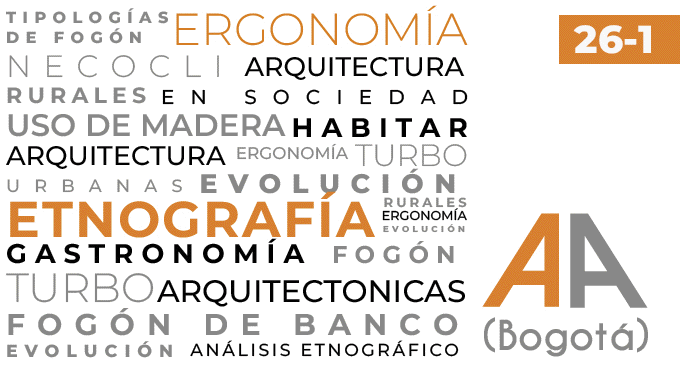

This work is licensed under a Creative Commons Attribution-NonCommercial 4.0 International License.
Revista de Arquitectura is an open access journal. More information...
Authors retain copyright and grant to the Revista de Arquitectura the right of first publication, which will be simultaneously subject to the Creative Commons (CC) BY-NC license.
Authors will sign a non-exclusive distribution license for the published version of the article by completing (RevArq FP03 Permission to Reproduce).
Self-archiving will comply with SHERPA/RoMEO guidelines and the Green classification.
To see in detail these guidelines, please consult...
Abstract
The conceptualization of what we know as architecture, is originated in the discovery of fire, allowing the need to cook and the evolution of the people, achieving the intellectual development and living in society. For this reason, this research establishes a study on the importance of the stove and its transition as an architectural component in Afro-descendant communities of the Colombian Caribbean, the above through an ethnographic and ergonomic analysis from the adaptation of man to the stoves. As a result, it is determined that the Binde transcends the bench stove as a result of the economy factors and improvement of postures linked to the ergonomics of the old cooks; as well as the transition from the bench stove to the industrial stove due to the risks produced by the use of wood as a biofuel, this supported in references, results of ethnographic analysis and interviews. However, it is established that the typologies of wood stoves are currently part of the gastronomic tradition, despite the technological developments linked to industrial stoves, present in rural and urban communities of the Municipality of Turbo and Necoclí.

References
Berroeta, H., Pinto-de-Carvalho, L., Di-Masso, A., & Ossul-Vermehren, M. I. (2017). Apego al lugar: una aproximación psicoambiental a la vinculación afectiva con el entorno en procesos de reconstrucción del hábitat residencial. Revista INVI, 32(91), 113-139. https://revistainvi.uchile.cl/index.php/INVI/article/view/62922
DeFelipe, J. (2011). The evolution of the brain, the human nature of cortical circuits, and intellectual creativity. Frontiers in Neuroanatomy, 5, 29. https://doi.org/10.3389/fnana.2011.00029
Fonseca, X. (2021). Las medidas de una casa: Antropometría de la vivienda. Pax México.
Gerbault, P., & Thomas, M. G. (2015). Human evolutionary genetics. En International Encyclopedia of the Social & Behavioral Sciences (pp. 289-296). Elsevier. https://doi.org/10.1016/B978-0-08-097086-8.82020-6
González-Díaz, M. J., & García-Navarro, J. (2016). Non-technical approach to the challenges of ecological architecture: Learning from Van der Laan. Frontiers of Architectural Research, 5(2), 202-212. https://doi.org/10.1016/j.foar.2016.01.005
Gowlett, J. A. J. (2016). The discovery of fire by humans: A long and convoluted process. Philosophical Transactions of the Royal Society B: Biological Sciences, 371(1696), 20150164. https://doi.org/10.1098/rstb.2015.0164
Harari, Y. N. (2014). Sapiens. De animales a dioses: Una breve historia de la humanidad. Debate.
Malinowski, B. (1973). Los Argonautas del Pacífico Occidental. Planeta-Agostini. https://ciroespinoza.files.wordpress.com/2011/12/los-argonautas-del-pacifico-occidental-vol-1-bronislaw-malinowski.pdf
Maza-Martín, J. J. (2013). Elaboración de soluciones constructivas y preparación de muebles UF0196. IC.
Meléndez, T. J. M., & Cañez-de-la-Fuente, G. M. (2010). La cocina tradicional regional como un elemento de identidad y desarrollo local: el caso de San Pedro El Saucito, Sonora, México. Revista de Estudios Sociales, 1, 182-204. http://www.scielo.org.mx/scielo.php?pid=S018845572009000300008&script=sci_arttext&tlng=pt
Montoya-Vera, M. (2007). Arquitectura de la “Tradición Mito” en el valle medio del Santa: Sitio “El Silencio”. Bulletin de l’Institut Français D’études Andines, 36(2), 199-220. https://doi.org/10.4000/bifea.3795
Muñoz, F., M., & Velasco, A., Y. (2015). Evaluación de posturas de trabajo en la actividad de archivar documentos de proyectos de investigación. Universidad, Ciencia y Tecnología, 19(76), 128-137. http://ve.scielo.org/pdf/uct/v19n76/art03.pdf
Naranjo, F. (2010). La problemática de la salud, en relación con las cocinas de leña en áreas rurales a nivel mundial. Éxito Empresarial, 123. http://www.cegesti.org/exitoempresarial/publicaciones/publicacion_123_130910_es.pdf
Panero, J., & Zelnik, M. (2017). Las dimensiones humanas en los espacios interiores. Gustavo Gili.
Patiño-Ossa, G. (2007). Fogón de negros. Cocina y cultura en una región latinoamericana. Convenio Andrés Bello.
Pérez-Padilla, J. R., Regalado-Pineda, J., & Morán-Mendoza, A. O. (1999). La inhalación doméstica del humo de leña y otros materiales biológicos. Un riesgo para el desarrollo de enfermedades respiratorias. Gaceta Médica de México, 135(1), 19-29. http://www.anmm.org.mx/bgmm/1864_2007/1999-135-1-19-30.pdf
Pizarro-Reyes, L., Díaz-Lazcano, V., Zumelzu, A., & Prieto, A. J. (2022). Resilience and sustainability assessment of cultural heritage and built environment: The Libertad pedestrian walkway in Valdivia, Chile. Journal of Cultural Heritage, 53, 154-164. https://doi.org/10.1016/j.culher.2021.11.013
Quiroz-Carranza, J. & Cantú-Gutiérrez, C. (2012). El fogón abierto de tres piedras en la península de Yucatán: tradición y transferencia tecnológica. Revista Pueblos y Fronteras Digital, 7(13), 270-301. https://www.redalyc.org/pdf/906/90624811010.pdf
Rehfuess, E. (2007). Energía doméstica y salud: Combustibles para una vida mejor. OMS. https://apps.who.int/iris/handle/10665/43705
Ruff, C. B. (2015). Body, Evolution of. En J. D. Wright (Ed.) International Encyclopedia of the Social & Behavioral Sciences (pp. 723-727). Elsevier. https://doi.org/10.1016/B978-0-08-097086-8.81028-4
Ruiz-Roa, U., & Navarro-Obeid, J. E. (2018). Enfoques, teorías y perspectivas de la Psicología y sus Programas Académicos. Corporación Universitaria del Caribe. https://doi.org/10.21892/9789588557748
Sánchez-Jaramillo, L. F. (2005). La historia como ciencia. Revista Latinoamericana de Estudios Educativos, 1(1), 54-82. https://www.redalyc.org/pdf/1341/134116845005.pdf
Soares, D. (2006). Género, leña y sostenibilidad: El caso de una comunidad de los Altos de Chiapas. Economía Sociedad y Territorio, 7(21), 151-175. https://doi.org/10.22136/est002006276
Torres-Duque, C. A., García-Rodríguez, M. C., & González-García, M. (2016). Enfermedad pulmonar obstructiva crónica por humo de leña: ¿un fenotipo diferente o una entidad distinta? Archivos de Bronconeumología, 52(8), 425-431. https://doi.org/10.1016/j.arbres.2016.04.004
Vargas-Cariola, J. E. (2003). Reseña de “La vida en Chiloé en los tiempos del fogón, 1900-1940” de Rodolfo Urbina Burgos. Historia, 36, 474-477. https://www.redalyc.org/articulo.oa?id=33414428024
Villar-Fernández, M. F. (2015). Posturas de trabajo: evaluación del riesgo. Instituto Nacional de Seguridad e Higiene en el Trabajo. https://www.insst.es/documents/94886/96076/Posturas+de+trabajo.pdf/3ff0eb49-d59e-4210-92f8-31ef1b017e66
































